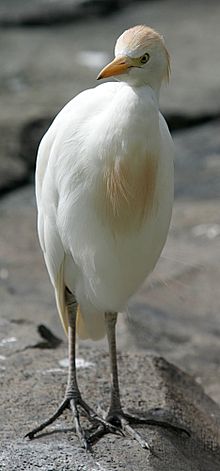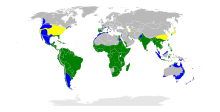Cattle egret
| Cattle egret | |
|---|---|
 |
|
| Breeding-plumaged adult of nominate subspecies | |
| Scientific classification | |
| Kingdom: | Animalia |
| Phylum: | Chordata |
| Class: | Aves |
| Order: | Pelecaniformes |
| Family: | Ardeidae |
| Genus: |
Bubulcus Bonaparte, 1855 |
| Species: | B. ibis |
| Binomial name | |
|
Bubulcus ibis (Linnaeus, 1758) |
|
| Subspecies | |
|
B. i. ibis (Linnaeus, 1758) |
|
 |
|
| Range of B. ibis breeding non-breeding year-round | |
| Synonyms | |
|
Ardea ibis Linnaeus, 1758 |
|
B. i. ibis (Linnaeus, 1758)
B. i. coromandus (Boddaert, 1783)
B. i. seychellarum (Salomonsen, 1934)
Ardea ibis Linnaeus, 1758
Ardeola ibis (Linnaeus, 1758)
Bubulcus bubulcus
Buphus coromandus (Boddaert, 1783)
Cancroma coromanda (Boddaert, 1783)
Egretta ibis (Linnaeus, 1758)
Lepterodatis ibis (Linnaeus, 1758)
The cattle egret (Bubulcus ibis) is a cosmopolitan species of heron (family Ardeidae) found in the tropics, subtropics and warm temperate zones. It is the only member of the monotypic genus Bubulcus, although some authorities regard two of its subspecies as full species, the western cattle egret and the eastern cattle egret. Despite the similarities in plumage to the egrets of the genus Egretta, it is more closely related to the herons of Ardea. Originally native to parts of Asia, Africa and Europe, it has undergone a rapid expansion in its distribution and successfully colonised much of the rest of the world in the last century.
It is a white bird adorned with buff plumes in the breeding season. It nests in colonies, usually near bodies of water and often with other wading birds. The nest is a platform of sticks in trees or shrubs. Cattle egrets exploit drier and open habitats more than other heron species. Their feeding habitats include seasonally inundated grasslands, pastures, farmlands, wetlands and rice paddies. They often accompany cattle or other large mammals, catching insect and small vertebrate prey disturbed by these animals. Some populations of the cattle egret are migratory and others show post-breeding dispersal.
...
Wikipedia

